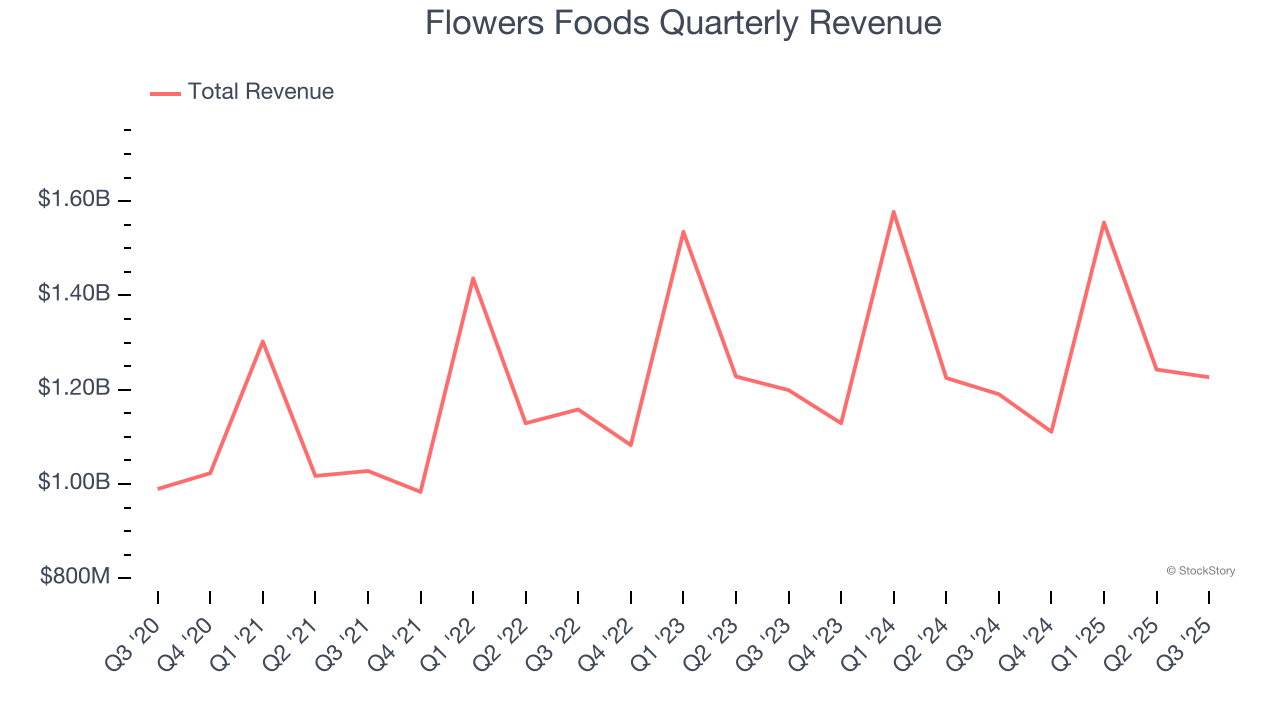
Packaged bakery food company Flower Foods (NYSE: FLO) met Wall Streets revenue expectations in Q3 CY2025, with sales up 3% year on year to $1.23 billion. The company’s outlook for the full year was close to analysts’ estimates with revenue guided to $5.28 billion at the midpoint. Its non-GAAP profit of $0.23 per share was in line with analysts’ consensus estimates.
Is now the time to buy Flowers Foods? Find out by accessing our full research report, it’s free for active Edge members.
Flowers Foods (FLO) Q3 CY2025 Highlights:
- Revenue: $1.23 billion vs analyst estimates of $1.23 billion (3% year-on-year growth, in line)
- Adjusted EPS: $0.23 vs analyst estimates of $0.23 (in line)
- Adjusted EBITDA: $118.1 million vs analyst estimates of $120.4 million (9.6% margin, 1.9% miss)
- The company slightly lifted its revenue guidance for the full year to $5.28 billion at the midpoint from $5.27 billion
- Management reiterated its full-year Adjusted EPS guidance of $1.05 at the midpoint
- EBITDA guidance for the full year is $523.5 million at the midpoint, below analyst estimates of $526.2 million
- Operating Margin: 5.4%, down from 8.1% in the same quarter last year
- Free Cash Flow Margin: 2.5%, down from 7.4% in the same quarter last year
- Sales Volumes were flat year on year (-2.4% in the same quarter last year)
- Market Capitalization: $2.56 billion
Company Overview
With Wonder Bread as its premier brand, Flower Foods (NYSE: FLO) is a packaged foods company that focuses on bakery products such as breads, buns, and cakes.
Revenue Growth
A company’s long-term sales performance is one signal of its overall quality. Any business can have short-term success, but a top-tier one grows for years.
With $5.13 billion in revenue over the past 12 months, Flowers Foods carries some recognizable products but is a mid-sized consumer staples company. Its size could bring disadvantages compared to larger competitors benefiting from better brand awareness and economies of scale.
As you can see below, Flowers Foods grew its sales at a sluggish 2.9% compounded annual growth rate over the last three years as consumers bought less of its products. We’ll explore what this means in the "Volume Growth" section.

This quarter, Flowers Foods grew its revenue by 3% year on year, and its $1.23 billion of revenue was in line with Wall Street’s estimates.
Looking ahead, sell-side analysts expect revenue to grow 3.3% over the next 12 months, similar to its three-year rate. This projection doesn't excite us and suggests its newer products will not accelerate its top-line performance yet.
While Wall Street chases Nvidia at all-time highs, an under-the-radar semiconductor supplier is dominating a critical AI component these giants can’t build without. Click here to access our free report one of our favorites growth stories.
Volume Growth
Revenue growth can be broken down into changes in price and volume (the number of units sold). While both are important, volume is the lifeblood of a successful staples business as there’s a ceiling to what consumers will pay for everyday goods; they can always trade down to non-branded products if the branded versions are too expensive.
Flowers Foods’s average quarterly sales volumes have shrunk by 1.9% over the last two years. This decrease isn’t ideal because the quantity demanded for consumer staples products is typically stable. 
In Flowers Foods’s Q3 2025, year on year sales volumes were flat. This result was a well-appreciated turnaround from its historical levels, showing the company is heading in the right direction.
Key Takeaways from Flowers Foods’s Q3 Results
It was good to see Flowers Foods provide full-year revenue guidance that met analysts’ expectations. On the other hand, its EBITDA missed and its EPS was in line with Wall Street’s estimates. Overall, this was a softer quarter. The stock traded up 3% to $11.99 immediately after reporting.
So should you invest in Flowers Foods right now? When making that decision, it’s important to consider its valuation, business qualities, as well as what has happened in the latest quarter. We cover that in our actionable full research report which you can read here, it’s free for active Edge members.






